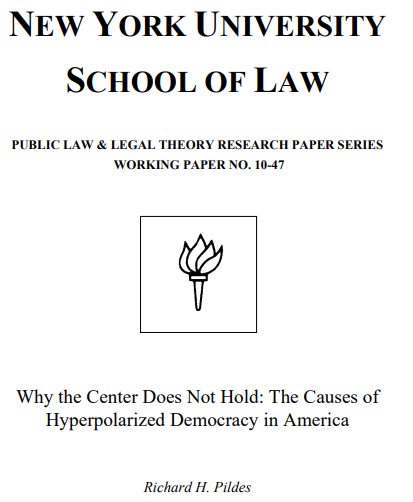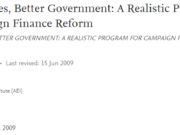In this New York University School of Law working paper by Professor Richard H. Pildes, examines the increase in partisan polarization and its effect on political parties. According to the author, we have not seen the intensity of political conflict and the radical separation between the two major political parties that characterizes our age since the late 19th century. Within Congress, the parties have become purer and purer distillations of themselves. The parties are now more internally unified, and more sharply differentiated from each other, than anytime over the last 100 years. Moreover, this polarization is not limited to those in office. Over the last generation, there has been a dramatic ideological and partisan sorting of voters as well. A center in America’s governance institutions has all but disappeared.
This article explores the causes of this polarization. Are the causes relatively contingent and short-term ones, so that it is possible to envision this structure of extreme partisan polarization changing, perhaps if certain institutional changes were made in the way American democracy and elections are designed? Or are the causes deep-rooted and structural ones, so that the appropriate conclusion is that this extreme partisan polarization is likely to be the ongoing structure of American politics and democracy for the coming years, regardless of any efforts that might be made to diminish this polarization? In particular, this article explores three potential causes of this polarization, which I label Persons, History, and Institutions.
“Persons” refers to the view that polarization is a reflection of particularizing polarizing personalities of various recent political figures, including Presidents. This view is reflected in the longing for the “statesmen” of past decades, who forged political breakthroughs across party and ideological lines to enact major policy initiatives. “History” describes the view that large-scale historical and transformative forces in American politics account for the modern structure, coherence, and polarization of the Democratic and Republican parties of today. The specific historical processes involve the end of the 20th Century one-party monopoly on the American South, which began with the 1965 enactment of the Voting Rights Act; the destruction of that world eventually led, by the 1990s, to the South having a system of genuine two-party competition for the first time since the Civil War. How much does the dramatic re-organization of American democracy entailed by that transformation account for the structure of partisan conflict today? “Institutions” refers to more discrete structures that organize democracy: the structure of primary elections, gerrymandering, campaign finance, and the internal rules that allocate power to political leaders in the House and Senate today. How much do these specific institutional features contribute to polarization, and in what ways, if any might they be changed to diminish it?
Ultimately, the article concludes that the major cause of the extreme polarization of our era is the historical transformation of American democracy and America’s political parties set into motion by the 1965 Voting Rights Act. Thus, perhaps the extreme polarization over the last generation should not be seen as aberrational (indeed, the pre-1965 structure of parties is the one to view as aberrational). This polarization, for better or worse, might be the “mature” structure of American democracy. As such, Pildes concludes it is likely to be enduring, despite efforts to transcend the extreme polarization of recent years.














